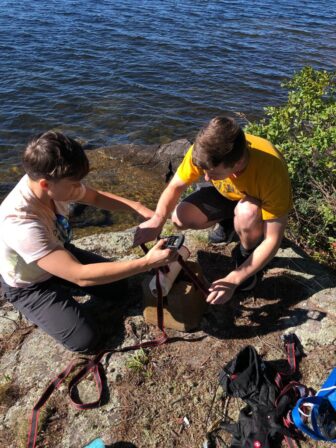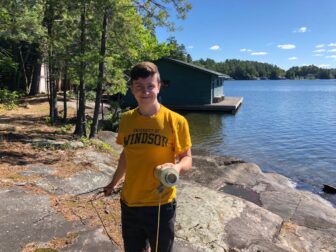
Third-year UWindsor student Ben Chittle helps strap one of his DIY pressure sensors to a cement block to keep it submerged. Image: Ben Chittle
By Jack Armstrong
A University of Windsor graduate student is busy pulling handmade devices out of lakes in a small Ontario township.
The devices, tied to cement blocks and submerged under about three feet of water, help student Abigail Carswell and other researchers understand how boat wakes erode the shoreline in Muskoka Lakes, a community about 145 miles north of Toronto.
Called transducers, these devices would normally cost over $7,000. But University of Windsor undergraduate student Ben Chittle is making them for around $200.
The devices measure the pressure of waves that come to the shoreline, Carswell said. Shoreline erosion disrupts ecosystems, clouds the water and threatens docks and other man-made structures. Understanding how waves affect a shoreline is key to fighting erosion.
“The interesting thing about this research is that shoreline erosion is known for sure when it comes to wind activity and storm activity, but there isn’t too much out there about vessel activity,” Carswell said.
The research is helped by Chittle’s do-it-yourself transducers that consist of a PVC pipe three inches thick and 10 inches long and capped at both ends. A pressure sensor is mounted on top of the cap and filled with epoxy to protect it from water. He has built 14 so far.
As a computer science student, working with hardware is new for him.
“Typically in computer science, you’re dealing a little more with the software side of things,” Chittle said. “I really enjoyed, once I really got into this project, the more electrical side of things – actually working with hardware and building these little computers.”
Chittle, a third-year student, started working with UWindsor’s Coastal Research Group in high school. He quickly demonstrated his ability for programming and environmental equipment development, said Chris Houser, the dean of science at UWindsor.
It’s a skill that paid off. The low cost of Chittle’s devices could help Houser cover a wider research area.
“I’m one of the only coastal geomorphologists left in the region, and that means there’s a lot of shoreline,” Houser said. “There’s a lot to be done. And if instruments are too costly, then I can’t scale to the right level.”
Carswell is using the data produced by the transducers to determine how much erosion various vessels cause in the Muskoka lakes.
“A lot of people around here own boats, or rent boats, and not all of them are necessarily properly educated on the techniques of driving the boats near shorelines,” she said.
Understanding the causes of erosion can help prevent it, Houser said.
But unlike with the impact of wind and storms, there’s a lack of data on how boat wakes may affect the shoreline.
“We really want to give local coastal managers and interest groups access to data, specifically looking at boat wakes, so then they can use this information to inform restrictions on vessel operation,” said Alex Smith, a postdoctoral research fellow associated with UWindsor’s Coastal Research Group. He is interested in improving the accessibility of technology.
Muskoka residents are grateful for the researchers’ attempt to understand how their vessels affect the local ecosystem.
“They are so thankful…they’re proud of the fact that they’re trying to have some changes made up here in terms of policies in regards to vessels,” Carswell said. “Vessels…can be enjoyed and should be enjoyed on the lake, but I think that people need to know what power they have in their hands when they’re driving.”
Chittle began work on the transducers after Houser sent him a research paper about DIY pressure sensors published in The Journal of Coastal Research in 2020. It details plans for the sensors and notes that they compare favorably with the far more expensive commercial models.
The data collected from the devices hasn’t been processed, so it’s hard to say how effective they are, Carswell said. If they can function as well as the transducers in the study they are based on, they will likely perform very well.

Third-year UWindsor student Ben Chittle poses with one of his homemade water wave sensors, which will be used to better understand the effect of boat wakes on shoreline erosion. Image: Ben Chittle
They are a work in progress – so there are some limitations. Chittle said the biggest downside so far has been trying to match the battery life and durability of commercial instruments. His transducers require more frequent battery changes than commercial models, and some have been water damaged. Chittle attributes this to the human error that emerges when trying to build 20 models of one device.
And there were a few glitches that muddled a small amount of data, Carswell said.
However, Chittle said he’s been able to make improvements without significantly increasing the cost.
“This summer, we were collecting data for a month at a time, and then we’d go up and change the batteries,” he said. “Towards the end of this summer, I was able to improve the custom transducers to have a battery life of three months without changing the battery.” Further design improvements are “very realistic,” he said
And the devices are precise. The DIY transducers are less than a centimeter off when calibrated with commercial sensors, Smith said..
If these transducers continue to provide commercial-quality data collection at a significantly lower cost, researchers would likely be able to understand the effect of boat wakes on shoreline erosion much better.
The research group wants the sensors to be accessible to anyone.
“We’re really interested in providing low cost and accessible sensors to any interest groups, which will allow us to then identify the relative contribution of wind waves versus boat wakes on coastal erosion,” Smith said.
Next, Smith said, the research group will process their raw data, separate wind waves from boat wakes and analyze the energy output separately to predict the degree of erosion associated with each.
People interested in learning more about the project can reach Chittle at chittle5@uwindsor.ca.